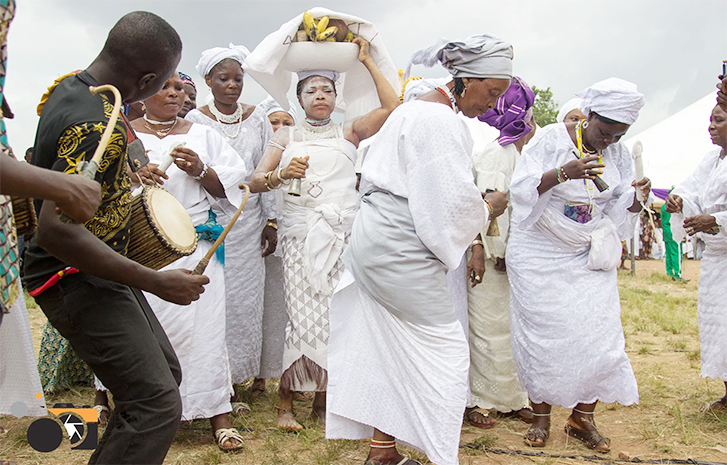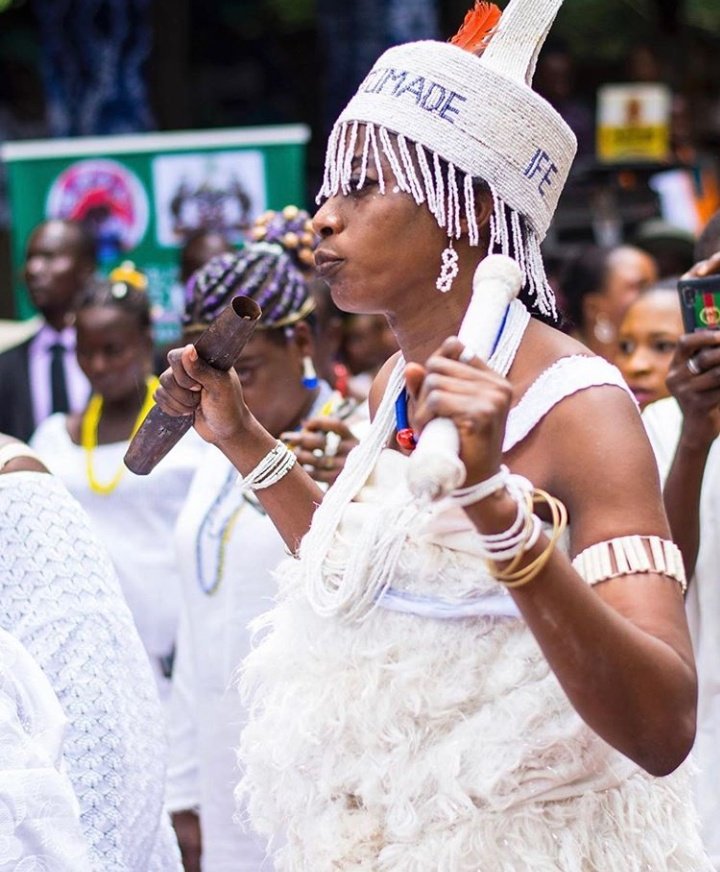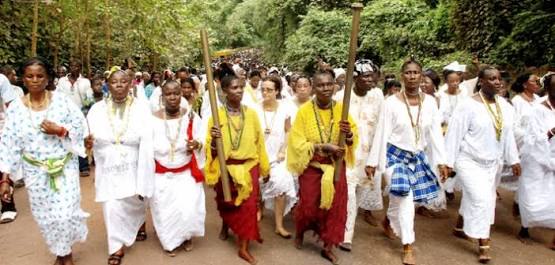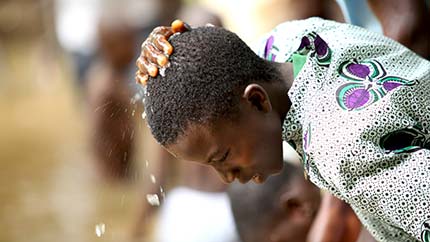The centrepiece of the Osun-Osogbo Festival is the Arugba (Calabash carrier). She is an Osun calabash-carrying votary virgin, which is a traditional allegory of the Virgin Mary. The calabash contains sacrifices intended to be made in her honour as offerings to the Osun goddess, or river. The Arugba is now worshipped as a goddess rather than just a virgin maid, and when she carries the calabash and leads the crowd to the river, people pray to her and blame all of their problems on her.
The symbolic calabash bearing the sacrifice’s offerings is carried by Arugba. This calabash is thought to have been given to the Osogbo forefathers by the goddess Osun, who stipulated that a royal virgin lady must transport it to the grove on the festival day. The Arugba is closely watched by the Olose (also known as Whip Boys) as she travels to and from the grove because she must avoid stepping on a stone or stump, as this would send the wrong message to the populace.

The Arugba Ritual
One of the main attractions of the Osun-Osogbo festival is a virgin votary carrying a calabash on her head, bearing the offerings that would be made in order to please and worship the goddess. People throw their concerns at her and offer prayers as she leads the procession to the river because they recognise her as a goddess-representative. The Arugba’s hitch-free journey from the palace to the groove is therefore crucial to the festival’s success. It should be noted that the Ataoja and the Osun priests and priestesses perform the holy rituals of the Osun festival in secret within the sanctuary at the Osun grove in order to renew the sacred tie and pathway between the goddess and the people of Osogbo.
The stage is set for the secular ritual drama, during which reenactments of some historical events take place to the admiration of the general public attending the festival after the sacred rituals have been performed at the inner sanctum of the grove by the initiates (Ataoja, the Osun priestess, and other priests). The Ataoja then sits on the stone of power in a designated area of the grove, communes with his ancestors, and feeds the goddess with the sacrifice after receiving it from the Osun priestess and Osun priest.

The Reenactment of the Events of the Early History of Osogbo
The act that is performed by the Ataoja and the Arugba is an important reconstruction of the occasions in Osogbo’s early history. First off, Olarooye, the first Ataoja, sat on the same stone that the current Ataoja is currently sitting on when he was about to make the first sacrifice to the goddess during the settlement of Osogbo. Additionally, the current Ataoja communes with the goddess and asks for her continuing assistance and protection in the upcoming year, just as Olarooye did before and after making the first sacrifice to the Osun goddess.
Finally, the Ataoja feeds the goddess like his ancestor and receives good tidings just as Olarooye received god-fish on his palm, which earned him the title “Atewogbeja,” shortened to ‘Ataoja’. The feeding of the goddess by the Ataoja marks the end of the rituals of the Osun festival and confirms that the waters of the river are blessed.
After the conclusion of the ritual, people will start shouting “Ore Yeye Osun,” which is Yoruba for “We adore you, Osun the Great Mother.” Additionally, people start drinking river water and collecting it in various kinds of containers, some of which they use to wash their faces. People believe that the river’s sacred waters, which are immediately available following the sacrifice, have the ability to heal all illnesses, including infertility, chronic headaches, and other conditions. Following that, the Ataoja and other individuals returned to the palace, where singing, drumming, and other forms of entertainment continued. The entire town of Osogbo is thrown into a celebratory mood thereafter. The singing of Osun praise poems (Oriki Osun) and festival songs (Orin Odun), which have a lot of historical significance, is one of the key components of the celebration of the Osun festival.

Osun Praise Songs and Poems
Poems and songs are extremely essential to the Yoruba culture, and there is never a Yoruba culture without lyrically beautiful traditional melodies. In reality, music serves as a mirror through which the Yoruba culture may be comprehended in its entirety because they use it not only to preserve and convey their past but also to call upon the spirits of their many Orisa. Throughout the two-week Osun celebration, worshipers and followers of the goddess of Osun shout praise and invoke her spirit at various times and locations. As previously mentioned, Osun praise poems and songs are rich in historical references that highlight the role of the Osun goddess in Yoruba cosmic mythology and Osogbo history. Below is a sample from one of those poems that highlight Osun’s significance in Osogbo’s history:
Sholagbade Ewuji, mo kore Yeye f’Osun Taa ni o momo p’Osun Osogbo Nii b’Oba selu Osogbo o? Osun Osogbo ni o ba mi Seyi ni temi.
Meanings: Solagbade Ewuji, I salute the Great Mother, Osun. Who does not know that it is the Osun Osogbo who helps the Oba manage or rule Osogbo? Osun-Osogbo is the one who will help me accomplish this one of mine.

Some of the words in the poem mentioned above depict her historical contributions to the creation, expansion, and development of Osogbo. First, Osun’s designation as the “Great Mother” (Yeye) in the poem refers to the goddess’ power to cure all types of human illnesses, especially those that affect mothers and young children. It also suggests that she can help infertile men and barren women become parents.
According to Osogbo legends, the goddess assisted Olarooye, the first Ataoja whose wife had difficulty conceiving children, to have children after consuming river water. This was the basis for the myth that the goddess could cure infertility and barrenness, which is why pregnant women flock to the grove during festival celebrations. The poem’s line that “it is Osun who helps the Oba rule Osogbo” refers to the goddess’ maternal role in the founding and development of Osogbo. The residents of Osogbo hold the belief that the Osun goddess generously permitted their forefathers to colonise their land and have since provided protection and security to the community. It is also asserted that the goddess’ continuous power and protection played a role in the fact that Osogbo had never been vanquished or conquered during a conflict. The residents of Osogbo even believe that the goddess actively took part in the famous battle of Osogbo between Ibadan warriors and Fulani Jihadists by disguising herself as a food vendor and tricking the Jihadists into eating poisoned bean cakes, which rendered them incapacitated, in order to fulfil her promise to keep Osogbo safe from invaders.





